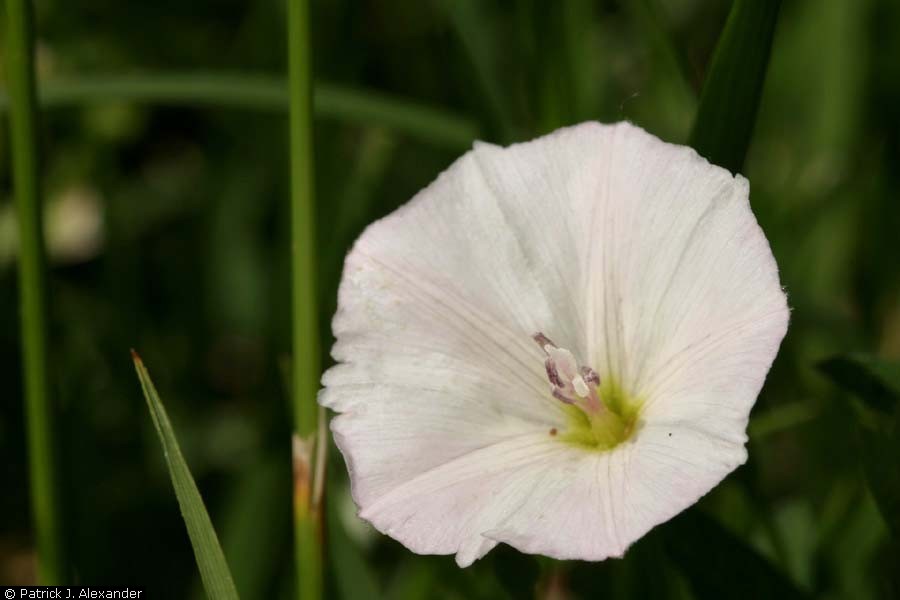Scientific Name: Convolvulus arvensis

Convolvulus arvensis photo by Patrick J. Alexander, hosted by the USDA-NRCS PLANTS Database
Common name: Field bindweed
Family: Convolvulaceae – morning glory
Article by Susan Bruneni
The delicate pink and white flowers along the sidewalk at Geneveva Chavez Community Center seem like charming wildflowers, but beneath their innocent appearance lurks a very destructive nature. Convolvulus arvensis, or field bindweed, is a member of the morning-glory family (Convolvulaceae). It is capable of entwining other plant life and covering the exterior, choking out sunshine, and depleting nutrients. Its long stems can jam harvesting equipment. Because of its extreme adaptability it is found up to 10,000 feet elevation.
Field bindweed originated in the Mediterranean area and the Middle East but is now found in temperate areas throughout the world. It was introduced into North America in the early 1700’s and was reportedly used in hanging baskets and as a ground cover. It is now considered one of the 10 worst weeds in the world. This species produces up to 500 seeds annually that can survive in the soil for 30 to 50 years. Flowers and foliage are similar to other morning glory plants but smaller with bell-shaped flowers and elongated, arrow-head leaves, with flowers from one-to-three inches wide.
Field bindweed also develops an extensive root system, reaching depths of 20 to 30 feet with lateral roots and rhizomes that help it spread and make it difficult to manually remove. Removal or grazing by sheep is temporarily effective, but field bindweed plants recover quickly because of carbohydrates stored in their root systems. And even worse, it is drought tolerant and resistant to extreme cold. In California, New Mexico, and Texas, estimated crop loss is in the millions. It is classified by the USDA as a “noxious weed” in 46 states.
According to organic grower Cebastien Rose, owner of Dryland Wilds in Vallecitos, NM, there are ways to limit bindweed’s growth. “If it’s a small garden of mainly annuals, I recommend a heavy sheet mulch put in place over the entire affected area plus a 10-foot margin (if possible) in time for the monsoon and winter moisture to water. Give the mulch extra water if necessary so that the cardboard and straw decompose and don’t just blow away. In addition, keep your eyes out for stray vines and remove them with as much root as possible” she said.
“Bindweed needs light to grow and smothering it is the most effective. Do not let any plants go to seed. And definitely do not try to till it away as you will make the problem much worse. Bindweed propagates some by seed, but more effectively by root division. They are very brittle — designed to break apart and create new plants from every tiny root piece.”
“Bindweed is edible, albeit not too tasty” says Cebastien. Goats like it. Chickens like it in the early spring before other better greens are up.
* * *
In the 1970s the bindweed mite, Aceria malherbae, was located in the Mediterranean area and brought to the United States for experimentation. The mites are introduced into an infected area and must be mowed frequently with mowed cuttings left on the ground to spread. They will winter over. Note: There is some criticism of bio-control methods. Be sure to research the pros and cons if you are interested. Former State Division of Forestry botanist, Bob Sivinski, recommends that mites not be used, because bindweed is much too similar to native occurring plants that might be negatively affected. He recommends the use of “Roundup” dropped on the leaves. This is tough for me because I have very strong feelings against “Roundup”.
The New Mexico State University’s Sustainable Agriculture Science Center at Alcalde has done extensive work with the mites and recently offered a three-hour workshop on using the mites, including a free bag of mites. A future workshop is planned during the Science Center’s Field day, August 11th, 2016. Call ahead if you plan to attend, 505-852-4241. You must bring a cooler and other items in order to take mites home.
References:
USDA
Wikipedia
wssa.net (Weed Science Society of America)
Weeds of the West


